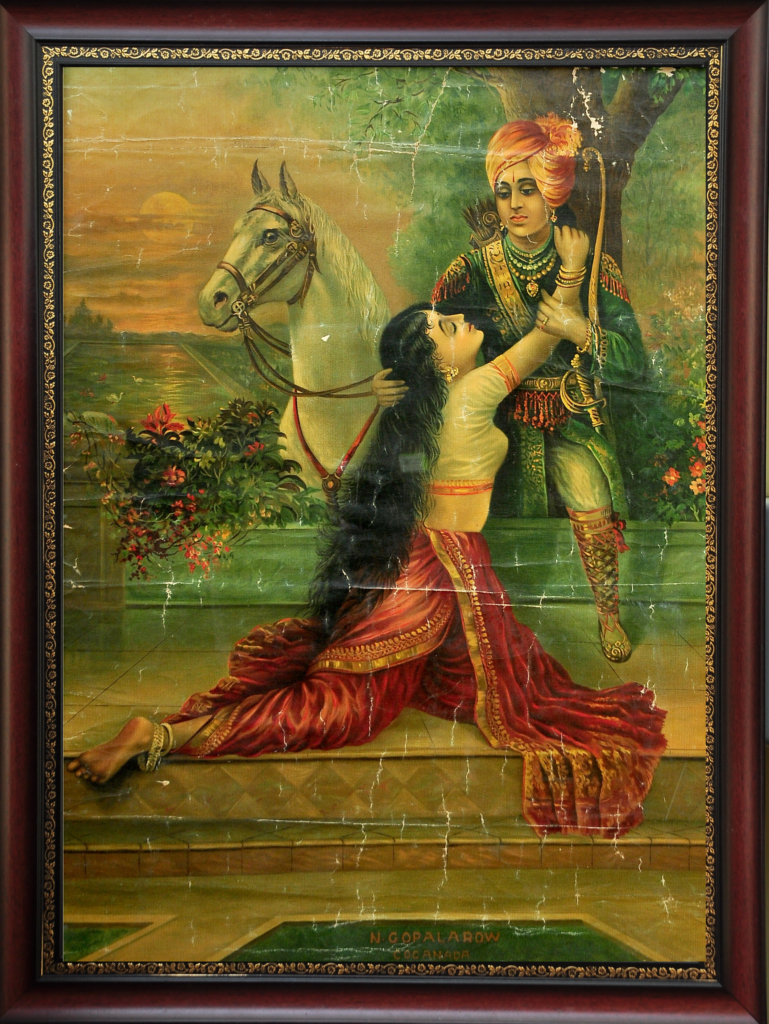UTHARA ABIMANYU
Gopala Row’s 1929 masterpiece “Uthra Abimanyu” captures a poignant moment as Abhimanyu comforts Uttarā before heading into battle. The painting received such acclaim that the artist later created another version in which Uthra’s eyes are open.
Drawing inspiration from the “Virata Parvam” chapter of the Mahabharata, the artwork poignantly portrays the love between Uthra, daughter of King Virata, and Abimanyu, son of Arjuna. Gopala Row’s skill is evident in the meticulous details, including the graceful folds of Uthra’s saree, highlighting his artistic vision.
The color palette is striking, combining vibrant reds, greens, and golds to create an emotionally charged atmosphere. A passionate admirer of flowers, Gopala Row often included floral motifs in his paintings, adding richness to both the background and foreground. His unique talent allows viewers to engage with the narrative in a way that few other artists can achieve, with themes of love, duty, and valor resonating powerfully throughout this heartfelt moment.
In the painting, Uthara is shown kneeling as she embraces Abimanyu with her right hand, while he holds her tightly with both arms. Her expression reflects her sorrow at the prospect of his departure for war, revealing her deep love and reluctance to let him go. Abimanyu, dressed in impressive warrior garb, is rendered with exquisite detail. The background features a rising sun and a robust horse, symbolizing readiness for combat and enhancing the painting’s overall emotional weight.
The Heart-Wrenching Farewell: Abhimanyu and Uttara
Their Meeting
Uttara is the daughter of King Virata, and Abhimanyu is the son of Arjuna and Subhadra. Their paths cross during the Pandavas’ exile when they are in hiding in Virata’s kingdom. Abhimanyu, known for his valor and skill in battle, captures Uttara’s heart. Their love blossoms amidst the backdrop of impending conflict, as the tensions between the Pandavas and Kauravas build.
The Promise of Love
Abhimanyu and Uttara’s relationship deepens, filled with dreams of a future together. They exchange promises of love and commitment, envisioning a life beyond the war that looms on the horizon. However, their happiness is overshadowed by the foreboding sense of the great battle that is about to unfold.
The Call to War
As the Kurukshetra war approaches, Abhimanyu must answer the call of duty. The night before he leaves for battle, he and Uttara share an emotional farewell. Uttara, fearing for his life, pleads with him to stay, but Abhimanyu reassures her, promising to return. He speaks of their future together and their child, filling her heart with hope, even as doubt lingers in her mind.
The Tragic Battle
During the war, Abhimanyu fights bravely, showcasing his incredible skills. However, he is ultimately trapped in a vicious attack by several Kaurava warriors who take advantage of his youth and inexperience. In a heartbreaking turn of events, he is killed in battle, leaving Uttara to face the devastating reality of his loss.
The Aftermath
Uttara, who is pregnant at the time of Abhimanyu’s death, is consumed by grief. She mourns the loss of her beloved and the future they had dreamed of together. Despite her sorrow, she gives birth to their son, Parikshit, who becomes the last ruler of the Pandavas’ lineage. Parikshit grows up to carry the legacy of his father and his heroic lineage.
Legacy of Love
The love story of Uttara and Abhimanyu, though marked by tragedy, is a testament to the enduring nature of love amidst the chaos of war. Their brief romance highlights the sacrifices made for duty and the personal tragedies that unfold in the larger narrative of the Mahabharata. Their son, Parikshit, symbolizes hope and continuity, ensuring that their love story lives on through generations.

